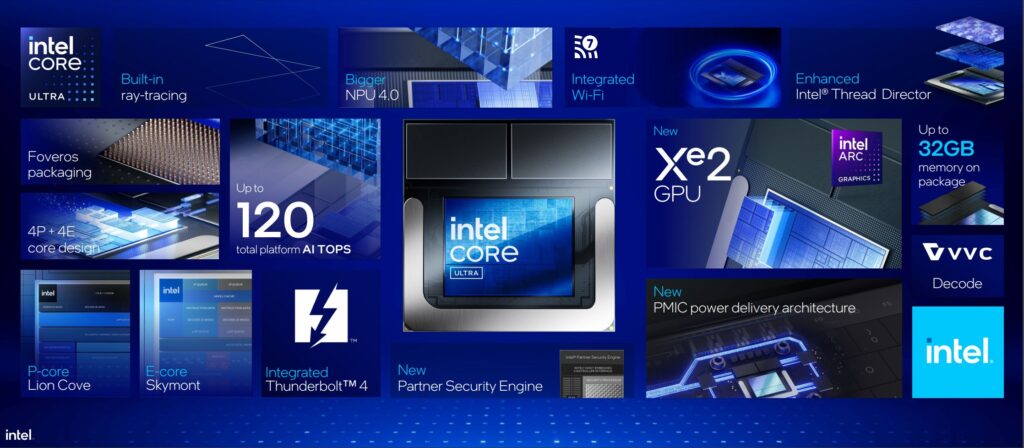Intel’s Core Ultra 20000 Series processors with their Arrow Lake architecture, packed with changes but receiving mixed feedback. Let’s dissect what Intel’s delivering, what’s lagging, and where they’ve positioned these processors in a tight competitive landscape with AMD.
Arrow Lake’s Core Ultra Series: New Technology, Familiar Expectations
Intel’s Arrow Lake series features several architectural shifts: gone are traditional designs, replaced by a tile-based architecture seen earlier in Meteor Lake. Each CPU includes the “Skymont” efficiency cores and the powerful “Lion Cove” performance cores in clusters, plus four XE Graphics cores, intended to elevate integrated graphics performance. While this setup aims to lower power consumption, it’s evident that performance swings and some limitations create a complex picture.
The Core Ultra Family: Boosting Productivity, but Gaming Takes a Hit
The lineup:
- Core Ultra 5 245K: Positioned as the “gamer’s choice,” this 6P-core, 8E-core CPU reaches up to 5.2 GHz, aiming to balance performance and power for gaming.
- Core Ultra 9 285K: An 8P-core, 16E-core powerhouse with a peak 5.7 GHz on select cores, tailored for productivity-focused users and multitaskers.
Gaming Performance: Misses the Mark
Intel aimed for gains in 1080p gaming but the Core Ultra series lags in specific gaming titles:
- City Skylines 2 saw a marginal uplift, with the Core Ultra 9 outpacing its predecessors in 1% lows but falling short against AMD’s recent Ryzen processors.
- Counter-Strike 2 and Shadow of the Tomb Raider highlight more challenges, where the Core Ultra 9 285K notably underperformed compared to its own predecessors in average FPS. This is due in part to changes in Intel’s threading approach and, as critics note, potentially premature implementation of certain architectural features.
Overall, the gaming metrics show a struggle for consistent performance, with the Core Ultra series delivering variable results across titles, failing to convince gamers it’s a major step forward.

Power Efficiency: A Silver Lining?
Efficiency claims: Intel’s promotional material highlights a substantial reduction in power consumption, often in the range of 30-40%, which directly translates to lower electricity bills. For example, in Final Fantasy 14, users see about a 40% drop in power usage while gaming, which aligns with Intel’s power-saving goals.
However, performance reductions accompany this efficiency, such as a significant 20% drop in FPS in high-demand games. This leaves a critical question: does lower power justify less power?
Productivity Potential: Solid Uplifts, But Trade-Offs Linger
When it comes to productivity, the new design pays off, especially in multi-threaded tasks:
- Blender and Handbrake benchmarks revealed noticeable efficiency, with both chips holding ground against AMD’s Ryzen 9000 series.
- In Cinebench, the Core Ultra 9 finally topped charts in multicore tests, placing Intel in competitive standing, albeit still trailing behind in single-core performance.
Intel’s strategic move toward adding E-cores (efficient cores) over traditional hyper-threading shows benefits in heavy, multi-threaded tasks. Nonetheless, the productivity-oriented improvements don’t address shortcomings in gaming or graphics performance.
Nvidia’s RTX 5090, 5080, and 5070 Set to Launch at CES 2025: Everything We Know So Far
The Integrated GPU: Better, but Still Underwhelming
The new XE cores in the Core Ultra’s integrated graphics are a notable attempt at raising standards. These are double the strength of prior generations, yielding performance improvements in OpenVino AI tests, where Intel’s chips surged by 82%. However, they still don’t rival AMD’s 3D V-Cache, which keeps a firm hold on gaming- and graphics-heavy applications.
Compatibility & Market Considerations: Added Cost of Transition
Intel’s Core Ultra series isn’t backward compatible with older motherboards. For adopters, the need to switch to the LGA 1851 socket and DDR5 memory hikes up the cost. As Intel refines their desktop roadmap, there’s a sentiment that Arrow Lake feels more transitional—like AMD’s Zen 1 series—rather than a groundbreaking leap forward.

Summing It Up: A Promising Start or Just a Growing Pain?
Intel’s Arrow Lake feels like a reset more than a leap forward. The Core Ultra 20000 Series makes significant steps in power efficiency and productivity performance, hinting at a roadmap that could flourish with further development. For now, the gains in gaming are underwhelming, and potential buyers might hesitate at the lack of clear advantages over AMD in the competitive gaming CPU market.
Intel has room to refine and evolve, but for now, this series may appeal primarily to those seeking productivity improvements or interested in Intel’s long-term roadmap—hoping for a payoff in future updates.

